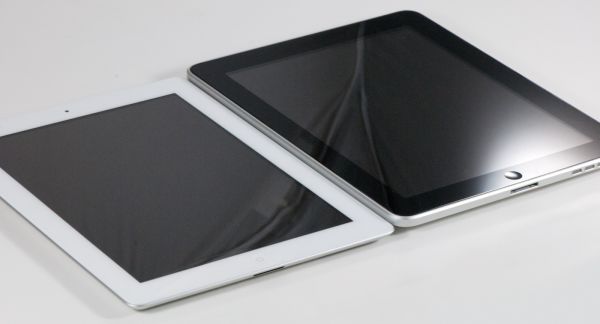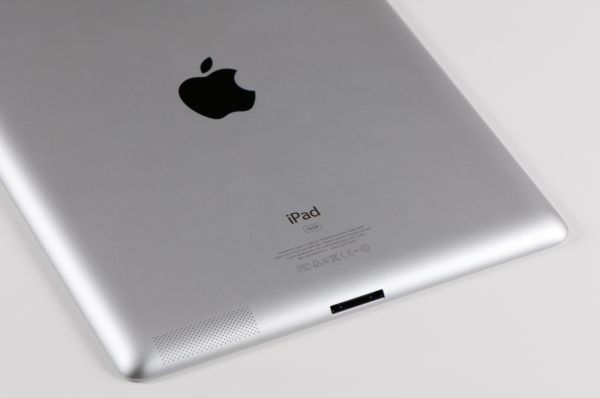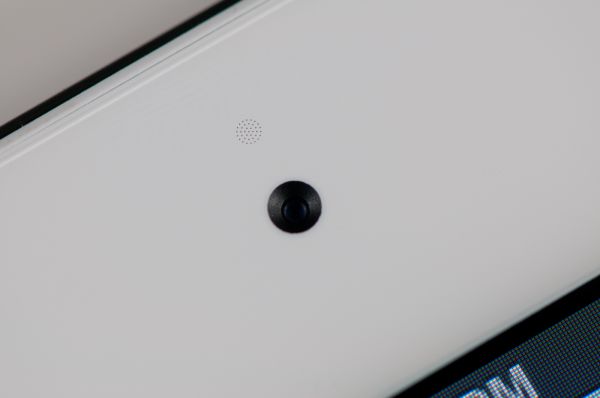Apple iPad 2 Preview
by Anand Lal Shimpi, Brian Klug & Vivek Gowri on March 12, 2011 6:01 AM ESTThe second generation iPad went on sale earlier today, to much fanfare and long, long lines. We're hard at work on our full review of Apple's second generation tablet but there were a few things we wanted to chime in on before too much time passed.
The iPad 2 is a very logical update to the original iPad. The hardware gets an upgrade, with revised industrial design, a slimmer chassis, and Apple's new A5 SoC inside. A5 brings along two Cortex A9 cores, a dual core version of PowerVR's SGX543 graphics chip, and 512MB of memory. Software stays mostly the same but gets some tweaks; the iPad 2 ships with iOS 4.3, which was released earlier this week as an update for the iPhone 4 and original iPad.
The industrial design has changed pretty significantly, from the convex curvature of the original iPad's back to the flat back of the new iPad. Starting with the iPhone 4, Apple has been moving away from the continuous curvature that dominated their handhelds two or three years ago (think iPhone 3G/3G-S, iPod touch 2G/3G, and the 4G/5G iPod nano) and more towards a flatter and more rectangular design language across the board. The iPhone 4 is the only one that's really angular, but the 4th generation iPod touch debuted the same flatness with more ergonomically friendly curves. The iPad 2 basically carries the iPod touch 4G design language on a larger scale.
The iPad 2 is slightly lighter but easier to hold than the previous generation. Laying in bed and reading is probably where the difference becomes most apparent. The gentle curvature running around the edge makes the in-hand feel surprisingly different, as does the considerably thinner profile. I'm actually shocked at how dramatic the difference is.
The downside to the very large radius curvature on the outside is that the dock connector is now awkwardly exposed. It's very similar to how the iPod Touch looks, with about 2 mm of exposed connector visible viewed from the back.
The previous generation dock connector was the subject of constant criticism for being way too tight. Apple has over-corrected with the iPad 2 and now the dock connector is too loose. Just browsing the Apple store, I noted several units whose dock connectors appeared plugged in, but had come just loose enough to not charge.
When connecting 30-pin dock cables, there's not too much resistance holding the cable in place, and the port itself is difficult to locate without flipping the thing over or viewing it from below.
Another welcome change - the return of the white iDevice. After the no-show that was the white iPhone 4, I was pleased to see Apple ship the white-bezeled iPad 2 on time with no production hitches. I was also wrong about how good white would look. Instead of being overwhelming or busy, the white bezel actually has one notable advantage over black - it doesn't show fingerprints or dust. That alone was what constantly drove me crazy about the previous generation - it always looked dirty. Shockingly, white seems to actually make sense.
Other hardware chances are the addition of front and rear facing cameras for FaceTime and taking pictures, but unfortunately, they seem to be pieces lifted from the iPod touch and nothing near the iPhone 4's 5 megapixel shooter. We'll talk about what this means for picture quality overall later on in the preview. The switch on the side can now be configured to either be a device silencer or a rotation lock switch, and there is now a large speaker on the bottom right corner of the device.
Overall, the new design really works - the iPad 2 feels good in hand, and instantly makes its predecessor feel a little clunky. But we didn't just pause our testing to talk about design, there's a lot under the hood of the iPad 2 that demands attention.














82 Comments
View All Comments
Seurahepo - Sunday, March 13, 2011 - link
Is there a problem with the comment system? This comment looks like it was from March 2010. :)Joking aside, I am not sure what you are comparing iPad with, but it is hard to see how it would be huge and bulky. Sure it is bigger than your cell phone, but it also gives you about seven times the screen area (comparing iPhone and iPad), which makes a big difference to how apps should make the layout and how gestures work.
You claim people purchasing iPads (and other tablets?) are stupid, which would be the better choice for them? Mobile phone? netbook? laptop? something else? Another tablet, just not from Apple?
Web browsing is one thing you can do with it, you can do your mail, you can play games etc. But the main thing is *apps*, which app is the killer app for you, I cannot know, but there are 65 thousand already out there and the number is growing. iPad like tablets is the future platform for a big group for apps. Not Windows PC or even Macs, those are the dinosaurs of the past, post PC-era is here.
vision33r - Saturday, March 12, 2011 - link
If it's pointless device to you then why do you bother reading this article and make complaints about it?Seems you got some anxiety or insecurities to work on.
Same question can be asked about anything in this world.
What's the point with a convertible sports car?
Why do some people use a briefcase and not a backpack?
sean.crees - Sunday, March 13, 2011 - link
Majority of my time lately online seems to be reading web pages, watching video's, checking email, listening to music.All of which is much more convenient on an Ipad. Notebooks are bulky to walk around with because of the attached keyboard. Smartphones are too small to clearly see what it is your doing. Smartphones may "work", but tablets make it more enjoyable.
So what i end up with is the freedom of a smartphone with the display size of a small notebook. Best of both worlds IMO.
I may not be able to put it in my pocket, but at least i don't need a chair to use it like a laptop. Have you ever tried using a laptop in your hands while you walk around with it? Its incredibly difficult.
While the ipad may not fit in my pocket, its small and light enough that i wouldn't mind just holding it in my hands as i walk around, or tossing it in a backpack/purse, or perhaps even getting a larger pocket sewn into the inside pocket of a jacket.
NCM - Monday, March 14, 2011 - link
Over 15 million buyers seem to have figured out the point of the original iPad, enough to pay $500 or more for one. Rather a lot to ascribe to mass hysteria. Maybe it's something in the water?Or did we somehow miss the news reports about hordes of disgruntled buyers demanding refunds for their "pointless" devices?
nitrousoxide - Saturday, March 12, 2011 - link
Please explain me this: In your XOOM review, it loads AnandTech.com in 603.1ms while it takes 2000+ms in this preview. Have you changed your benchmark suite?Anyway I believe that Google's Android is simply a waste of hardware power. It's a poorly optimized OS, no matter Gingerbread or Honeycomb. The only way for it to keep up with iOS or Windows Phone is using superfast chips but when that hardware advantage is gone, it stands no chance.
Seurahepo - Sunday, March 13, 2011 - link
Yes, they changed back to hand timing, because the results from the Android browser were strange.name99 - Saturday, March 12, 2011 - link
"The iPad 2 maintains full 5 GHz (802.11a/n) support, "This is not so. As far as I can tell, for example, 5GHz 40MHz channels are not supported. This is the big one. I don't have the kit to test it, but it would not surprise me short guard intervals and some of the other optional protocol niceties that buy you a few percent (to, sometimes many 10s of percent) here and there are also not supported.
More generally, might I make a plea that you institute some sort of standardized benchmark for testing the quality of WiFi (and 3G, though for iPad I care about this less) implementations?
The reason I ask is that
- for reasons I don't understand Apple (quietly and behind the scenes) seems to keep pushing to always have better wireless kit than the competition (eg 3 active antennas in the newest MacBook Pros and Airport Base Station) while the competition lag BUT
- the quality of wireless in these devices is an easy target for improvement right now, adding in more antennas and smarter decoding algorithms.
In other words, it seems to me that an OBVIOUS way for the next great tablet to differentiate itself from iPad2 is through having multiple antennas (both WiFi and 3G) hooked up to competent firmware and OS code, such that it could achieve double or better WiFi bandwidth, and a much more robust WiFi and 3G experience.
It would be nice, if this happens, for AnandTech to be able to verify the truth of the (doubtless exaggerated) statements the marketers will make, and more generally to play the same role here that it has played in SSDs in just pushing awareness of the state of the art forward and not allowing manufacturers to get lazy. (I'd regard, for example, Apple's unwillingness to boost the WiFi here over iPad1 as an example of being lazy because they can get away with it. They have no competition in the tablet space, and it's not something reviewers look at carefully and complain about.)
Seurahepo - Sunday, March 13, 2011 - link
While making a better wifi implementation may seem like an obvious way of differentiating from iPad it is far from it. Better networking implementation is very hard to market for the general population. The only viable way seems to be marketing by buzzword, marketing the same buzzword with "better implementation" will be hard.For the non-geek the speed is often more than enough, they are used to the fact that computers take their time. And even if they found it to be slow, they would not know what is the reason.
Brian Klug - Monday, March 14, 2011 - link
So the iPad 1 and 2 both only support the long guard interval (65 Mbps) MCS on both 2.4 and 5 GHz channels, with only 20 MHz support.I consider this "full" mobile support only because the majority of "802.11n" mobile devices do the same thing - 65 Mbps, or in rare circumstances short guard interval 72 Mbps.
Keep in mind, the iPad 1 already was the differentiating product, as it was the first smartphone/tablet that came with 5 GHz support at all. The myTouch 4G and Galaxy S 4G both also have 802.11a/n support with 72 Mbps.
I've definitely been testing/pushing for more/better antenna and connectivity, and it's interesting that Apple chose to essentially keep the same WiFi stack as they had in the previous version. That said, baseband has definitely improved ;)
-Brian
btdvox - Saturday, March 12, 2011 - link
I disagree with your comment on the White iPad, I had a choice between the White 32 and Black 32, and after seeing demo models of both yesterday, it's clear the White looks very cheap, the Service Rep told me it's actually not covered with glass but rather the components of the white macbook and can be prone to staining.Sure it doesn't show finger prints, but watch any movies, and websites that use dark schemes (Which every movie does and most websites do), even the top bar is black (status bar), and with a black bezel, these components all "seam" together, and even the hardware (things like the light sensor, camera etc, are barely visible).
With the White bezel all these components make the ipad less seamless and I thought the display on the white looked worse, simply because of it's bezel.
The same goes for TV's, would you rather watch a movie on a TV with a white or grey bezel or a glossy black one? I'll always choose glossy blacks, it makes the display look better.
Still pictures suck on the ipad 2, just like they do on the ipod gen 4 but Video is really good, on par with iphone 4! Sucks that they didn't spend the same components on the iPad 2 camera, wish they did!! No autofocus kind of sucks too!